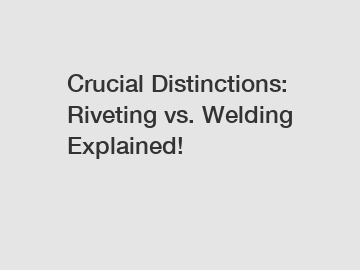Crucial Distinctions: Riveting vs. Welding Explained!
Crucial Distinctions: Riveting vs. Welding Explained!
When it comes to joining metals together, two popular techniques stand out: riveting and welding. Although they both serve the purpose of connecting different components, they differ significantly in terms of their execution and end results. In this article, we'll delve into the crucial distinctions between riveting and welding, enabling you to make informed decisions about which method suits your project best.
Riveting, a tried and true technique dating back centuries, involves fastening two or more metal pieces together using metal pins or rivets. These fasteners are inserted through pre-drilled holes and then pulled tight, securing the parts in place. Riveting offers several advantages over other joining methods, including its ability to withstand heavy loads and harsh environmental conditions.

Welding, on the other hand, is a more modern approach that involves melting metal pieces together. By using intense heat, a welder joins the materials, creating a robust bond. Welding has gained popularity due to its ability to create seamless connections that are incredibly durable, often surpassing the strength of the base metals themselves.
One crucial distinction between riveting and welding lies in the permanence of the connections. Welding produces joints that are typically permanent and require specialized tools and expertise to undo. In contrast, riveting allows for disassembly and reassembly, making it an attractive option for projects that may require future modifications or repairs.
The application also plays a significant role in deciding between riveting and welding. Riveting is often the preferred method in industries such as automotive, aerospace, and construction, where the ability to withstand high stress and vibrations is critical. The use of rivets ensures the connection remains steadfast, even under extreme conditions. Welding, on the other hand, shines in applications where a continuous and seamless connection is desired, such as shipbuilding and pipelines.
When it comes to efficiency, welding often takes the lead. The process requires less time compared to riveting, making it a popular choice for large-scale production and manufacturing. However, it's worth noting that riveting does not require the same level of surface preparation and joint alignment as welding, making it a more forgiving option for irregular or mismatched components.
Safety is another area where riveting and welding differ significantly. Welding involves the use of high temperatures, hazardous gases, and potentially harmful radiation. This necessitates the use of protective gear, proper ventilation, and adherence to stringent safety standards. Riveting, on the other hand, does not involve any such risks, making it a safer option for certain situations.
When it comes to aesthetics, welding offers a distinct advantage. The seamless joints created through welding leave minimal visible evidence of the joining process. This allows for a smoother and more visually appealing final product. In contrast, riveting produces visible metal pins or rivets, which can be seen as a design element by some or a potential drawback by others.
Ultimately, the choice between riveting and welding depends on various factors, including the intended purpose, environmental conditions, project scope, and safety considerations. Each method brings its own set of benefits and constraints, making it crucial to evaluate your specific requirements and consult with professionals before making a decision.
In conclusion, riveting and welding may appear similar at first glance, but upon closer inspection, their distinctions become clear. Riveting offers versatility and ease of disassembly, making it suitable for projects that require future modifications. On the other hand, welding provides strength and durability, creating seamless connections that are ideal for applications requiring continuous integrity. Understanding the crucial differences between these methods empowers you to make well-informed choices, ultimately leading to successful projects and satisfied clients.
Are you interested in learning more about stator in dc motor, lamination welding, Epoxy Coated Rotor for bldc motor? Contact us today to secure an expert consultation!
132
0
0

Comments
All Comments (0)